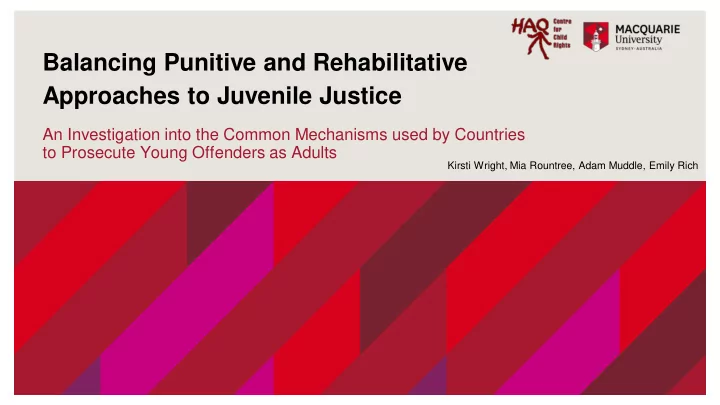

Balancing Punitive and Rehabilitative Approaches to Juvenile Justice An Investigation into the Common Mechanisms used by Countries to Prosecute Young Offenders as Adults Kirsti Wright, Mia Rountree, Adam Muddle, Emily Rich
This presentation is based on the report titled, Balancing Punitive and Rehabilitative Approaches to Juvenile Justice, prepared by Kirsti Wright, Mia Roundtree, Emily Rich and Adam Muddle, senior law students from the Macquarie University’s Law Department. The report provides insight and understanding on different approaches to juvenile justice in 15 countries, particularly in the light of international standards, increasing use of ‘waivers’ to try juveniles as adults and the use of psychological assessments. It is part of the LAWS552 PACE International Remote Internships Programme carried out through partnership between the Macquarie University in Sydney, Australia and HAQ: Centre for Child Rights, an NGO based in New Delhi, India. The project was carried out under supervision of Debra Ronan (PACE Supervisor at Macquarie University) and Bharti Ali (Co-Founder & Executive Director at HAQ). 2
What we will discuss 1. Brief Overview 2. What drives juvenile crime? 3. Theory: Approaches to juvenile justice 4. International Standards 5. ‘Populist Politics’ 6. Juvenile Waiver overview 7. Psychological Assessment overview 8. Welfare Approach ○ Canada 9. Justice Approach ○ Saudi Arabia 10.Hybrid Approach ○ Belgium and USA 9. Recommendations / Further Research 3
Our Research Goal What did we set out to achieve? 1. An understanding of the common mechanisms used by countries to prosecute young offenders as adults i.e. juvenile waivers. 1. An understanding of how psychological assessments are used to determine capacity and criminal responsibility. 1. Analysing how these two focus areas (theory) are implemented in legal systems across the globe (in practice). 4
What Drives Juvenile Crime? Causes of juvenile crime 5
Different Approaches to Juvenile Justice Three different models 1. Welfare Model 2. Justice Model 3. Hybrid Model (justice model/welfare model) • • • Parens patriae Punitiveness Combination of approaches from • • Child protection Incapacitation both the welfare and justice models • • Education Punishment • • Rehabilitation Retribution • E.g. High age of criminal • • Restorative justice Deterrence responsibility + juvenile waiver • • Best interests of child Victim support (Belgium) • Judicial waiver • E.g. Educational reforms + wide judicial discretion when sentencing (Malaysia) • E.g. Ratification of international instruments + cultural and religious principles 6
Populist Politics, Moral Panic and Sensationalist Media Reporting OFFICE | FACULTY | DEPARTMENT 7
International Standards Serious Young Offenders and International Standards of Sentencing ‘Every person under the age of 18 years at the time of the alleged commission of an offence must be treated in accordance with the rules of juvenile justice’ . Shortest Participation by Best - Interests Community Detention as a appropriate time juvenile of juvenile Safety last resort in cases of detention Are a range of Is the sentence sentencing Cruel, inhuman free from Rehabilitation Proportionality options or degrading arbitrariness? available? 8
Juvenile Waiver Common mechanism by which to try juveniles as adults Opportunity for the use of psych assessments Factors considered: - Risk to the community (welfare Judicial Waiver - Severity of the offence considerations) (discretionary) - Maturity and character of the juvenile No psych - Legal history - Nature of the offence assessments (justice Juvenile considerations) Waivers Legislative Waiver (statutory) OFFICE | FACULTY | DEPARTMENT 9
Psychological Assessments • Risk assessments using Risk, Sophistication-Maturity, and Treatment Amenability instrument or the Structured Assessment of Violence Risk in Youth (SAVRY) ● Assessments Used to triage or • Needs to evaluate dynamic MH ‘sort’ juveniles to & capacity conditions appropriate testing • Mental health assessments – looking for ● The Massachusetts underlying mental health disorders Youth Screening • Youth Level of Service/Case Post Screening Instrument-Version Management Inventory adjudication 2 (MAYSI-2) / triage on ● Problem-Oriented mechanisms entering Screening Instrument justice for Teenagers (POSIT), and the • Personality, i.e. Minnesota Multiphasic system Child and Adolescent Personality Inventory • Behavioural, i.e. Revised Behaviour Functional Problem Checklist General Assessment • General Intelligence, i.e. Wechsler (CAFAS) psychological Intelligence Scale for Children • Emotional functioning, i.e. Hare testing Psychopathy Checklist: Youth Version 10
11
Welfare Model Approach 1 OFFICE | FACULTY | DEPARTMENT 12
France CHILD WELFARE 13
Belgium CHILD WELFARE 14
Justice Model Approach 2 Juvenile Justice OFFICE | FACULTY | DEPARTMENT 15
Saudi Arabia JUSTICE MODEL 16
Hybrid Approach Hybrid model (welfare + justice) OFFICE | FACULTY | DEPARTMENT 17
United States of America HYBRID MODEL 18
China HYBRID MODEL 19
Further Research • Kirk Heilbrun, David DeMatteo, Thomas Kline and Naomi Goldstein (eds), APA Handbook of Psychology and Juvenile Justice (American Psychological Association, 1st Edition, 2016). ― Excellent resource on psychological evaluations, social inquiries, risk assessment, training professionals to perform psych evaluations etc. in the U.S. • Ton Liefaar and Maryse Hazelet, ‘Alternatives to Custody for Young Offenders: National Report on Juvenile Justice Trends (Netherlands)’ (Comparative Report, International Juvenile Justice Observatory, 2012). • Sabien Hespel and Johan Put, ‘Alternatives to Custody for Young Offenders: National Report on Juvenile Justice Trends (Belgium)’ (Comparative Report, International Juvenile Justice Observatory, 2012). ― Two excellent and recent resources on juvenile transfer in Belgium and the Netherlands • Government of Canada, ‘Youth Risk/Need Assessment an Overview of Issues and Practices,’ Department of Justice (Web Page, 1 July 2015) <https://www.justice.gc.ca/eng/rp-pr/cj-jp/yj- jj/rr03_yj4-rr03_jj4/a1.html>. ― 42 item list to survey youth in Canada, including scientific and psychological assessments 20
Recommend
More recommend